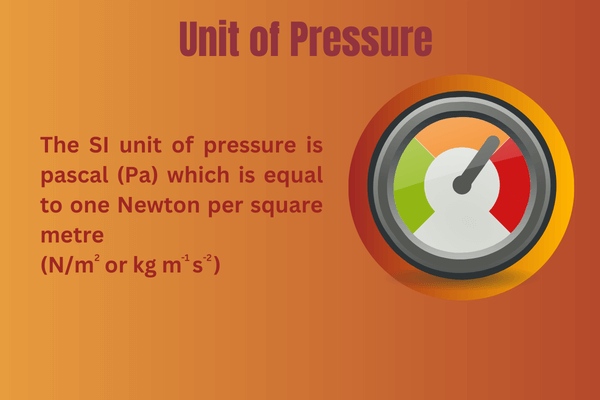The SI unit of pressure is pascal, which is represented as Pa, and is equal to one newton per square meter (N/m2 or kg m-1s-2). The CGS unit of pressure is barye (Ba) which is equal to 0.1 Pa or 1 dyne per cm2. Here dyne is the force required to accelerate the mass of 1gm to the rate of 1 cm per second. Pressure depends on two factors that are the force applied and the area of the surface. The less the surface area, the easier it is for the work to be done. It is defined through various units, SI, CGS, and many more.
Table of Contents
What is Pressure?
Pressure is the force that is applied to a surface to get the work done. Let’s consider cutting fruit with a knife. If we try to use the flat surface of the knife to cut the fruit, then probably nothing will happen. But if we apply force from the edge of the knife, then we’ll be able to cut the fruit. Similarly, if we try to hammer a ball on the wall, then nothing would happen, but if we hammer a nail on the wall then the nail would penetrate the wall. Therefore, it can be summarized as:
- Pressure is defined as the amount of force acting per unit area.
- It is expressed as the formula: P=F/A.
- Where P refers to Pressure produced by the object, F refers to the Force applied to the object, and A refers to the area of contact of the body surfaces.
Unit of Pressure
There are various units for pressure, used differently in different places. Therefore the SI and CGS unit is set, so that everybody can achieve one value from its standard form. We’ll be looking at these units separately.
SI Unit of Pressure
The SI Unit of pressure is Pascal, represented as ‘Pa’. It is equal to one newton per square meter (N/m2 or kg m-1s-2).
- Before 1971, pressure in SI was measured in newtons per square meter.
- It was named after the French mathematician Blaise Pascal.
- It is defined as 1 Pascal equals 1 Newton per square meter or 1Kilogram per meter square second.
1Pa=1Nm2
or,
1Pa=1kg.ms2
CGS Unit of Pressure
The CGS/ MKS unit of pressure is barye, represented as Ba. It is defined as 1 Barye is equal to 0.1 Pascal or 1 dyne per square centimeter. 1Ba=0.1Pa
Or,
1Ba=1dyne/cm2
Other Units of Pressure
There are many other units of pressure used in different places. Some of these other units include the following:
- Pounds per square inch
- Bar
- Unit of atmospheric pressure (atm)
- Centimeters of water
- Inches of Mercury/ Millimeters of Mercury
- TSW
- Torr
- FSW
The table below will explain in brief how pressure is related to its units:
| Pascal | Bar | Standard Atmosphere | Torr | Pounds per square inch | |
| (Pa) | (bar) | (atm) | (Torr) | (Ibf/in2) | |
| 1 Pa | 1N/m2 | 10-5 | 9.869210-6 | 7.500610-3 | 0.000145037737730 |
| 1 bar | 105 | 100kPa106dyn/cm2 | 0.986 92 | 750.06 | 14.503773773022 |
| 1 atm | 101325 | 1.01325 | 1 | 760 | 14.6959487755142 |
| 1 Torr | 133.322368421 | 0.001333224 | 17600.001315789 | 1mmHg | 0.019336775 |
| Ibf/in2 | 6894.757293168 | 0.068947573 | 0.068045964 | 51.7714932572 | 1Ibf/in2 |

